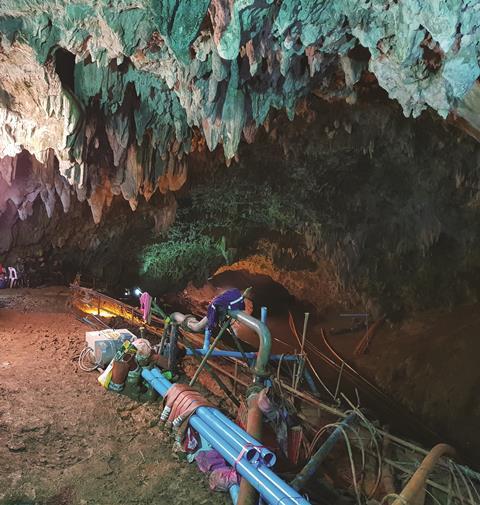Important risk management lessons emerged from this summer’s dramatic rescue operation, as Juliana Sutanto, professor of information systems at Lancaster University, explains

Accidents happen. But a lot of lessons can be learned as a result. The story of the young Thai football team trapped in an underground cave network was one accident which captured the hearts and minds of people around the world.
Thankfully in this case there was a positive outcome. But my research– which involves examining emergency planning in South-East Asian countries – has revealed that there is a distinct lack of record keeping when it comes to such rescues.
This vitally important information – built up from similar rescue operations in the past – could have been used in Thailand and could have improved the speed of the rescue. The rescue team was still debating how best to evacuate the boys 11 days after the operation began. It boils down to the emergency plan and responses: the inter-organisational coordination, the skills and infrastructure that is needed to respond effectively.
My study is looking at how to optimise emergency plans. One way to achieve maximum efficiency in the future is to include archiving historical incidents and responses and building a knowledge database. For example, the media linked the Thai cave rescue operation to the 2010’s Chilean miners’ rescue where 33 miners were trapped for more than two months.
Two Chilean doctors who designed a training and counselling programme were interviewed about what insights they could provide to the Thai rescue team. They passed on information about how to protect the team’s mental health and unity. This is an example of valuable lessons not being properly archived in a searchable database. Currently, the only way for any rescue teams to learn from similar past incidents is through scattered information in the media and on the internet.
During this particular event, organisers spent lots of time and effort mapping the terrain intricacies and coordinating the expertise, skills and infrastructure necessary for the rescue operation. They discounted scenarios as they gained more information and managed volunteers to align the entire operation. This is vital information that needs to be kept and stored on file.
Analysing historical data
Poor archiving of data is a problem in most countries in South-East Asia. The knowledge of rescue plans and operations stay with the individuals involved. Usually, there is little to no effort to store this knowledge as there are no information systems available for storing historical incidents and responses in a systematic and structured way.
Without the database of past incidents and their corresponding rescue plans and operations, it is difficult – if not impossible – to design and develop a computer application that can propose optimised plans when similar incidents happen in the future. It is therefore important to start the archiving process even when some information is incomplete.
Structured plans can then be designed based on the different types of incidents. Overtime, with more complete information, the plans can be refined. Instead of making rescue plans based on selected people’s memory, the decision makers can receive some objective pointers from the computer application.
It is vital to develop decision support systems (computer applications that analyse historical data) using models and algorithms to assist with decision making. Based on comparable past incidents and contextual information of the current incidents, such as weather information, the systems will propose alternative rescue plans.
In emergency situations, where people tend to panic yet fast action is crucial, such a system is useful to support much more informed and systematic planning.
Monitoring
It is also obvious from this incident that monitoring in such a dangerous cave is severely lacking. It is not unusual to find a dangerous place accessible by members of public with only a “Do not enter” sign, which is often not enough to put off some thrillseekers. Indeed, what worries me now is that following this high-profile news story, the thrill-seekers will be tempted to go and investigate this now-famous cave.
Putting in place monitoring tools, such as security cameras and sensors, in all such places is not feasible. But there is an opportunity here.
In this situation a fibre-optic cable was laid over the cave and radios equipped with mesh technology were used for communication so there was no need for a network tower. Without the appropriate communication infrastructure, it is not possible to transmit any signals from inside a cave such as this. But with mesh technology, it is possible for sensors to transmit signals from one another radio to another inside such a communication “blind spot”.
This technology should now be further developed towards a remote monitoring system – as monitoring and prevention are far better than a full-blown rescue. The authorities could perhaps leave this infrastructure in place now to serve as a foundation to build a new system which would pick up people as they entered the cave and alert the relevant authorities immediately. In this way the Thai authorities could begin leading the way for such rescues in South-East Asia and be a real beacon of hope in the dark.
Implications for risk management
Beyond the emergency plan and rescue operation, this incident offers some important lessons for organisations, especially for risk management. Poor archives of historical data and lack of real time monitoring data pose a serious challenge to risk managers in identifying, characterising, and assessing risks (and opportunities). On the other hand, having masses of data may be overwhelming. Risk managers may benefit from having the support of a computer application that provides recommendations about how the risks should be prioritised based on historical data and assessments.
Since risks are not static, there will always be an element of unpredictability. Hence, effective risk management should be a mix between intuition and science; the portion of which depends on the intelligence of the application in learning about the current events and adjust the future recommendations accordingly.
The rescue
23 June: 12 members of a Thai football team and their coach head down to the Tham Luang Nang Non cave in Northern Thailand, after football practice. Torrential rain blocks the main entrance and they become trapped. Local authorities discover bikes, football boots and shoes close to the entrance of the cave.
24 June - 1 July: A major search operation is launched. Thai Navy Seal divers begin the initial underwater search and are later joined by American military and three British divers. Heavy rain continues and floodwaters inside the cave increase, causing difficulties with the search operation. The football team and their coach retreat further into the cave to an ‘air pocket’ called Pattaya Beach.
2 July - 7 July: The boys and their coach are found alive after being trapped in the cave for nine days. They are about 2.5 miles from the entrance. The rescue team prepares evacuation plans, which include draining gallons of floodwater from the cave, pumping oxygen to aid the entrapped group’s recovery.
8 July - 10 July: At about 11:00, rescue teams enter the cave, navigating through dangerous, tight and complex passageways and strong currents. About 0.9km of the rescue is underwater. Attached by rope, two divers guide each boy through deep water, after which they walk to the entrance of the cave. At 19:55 the first four boys are rescued. On 9 July, four more boys are rescued and the following day, the last four and the coach are successfully guided out of the cave.
This article is republished from The Conversation under a Creative Commons license. Read the original article.





















No comments yet